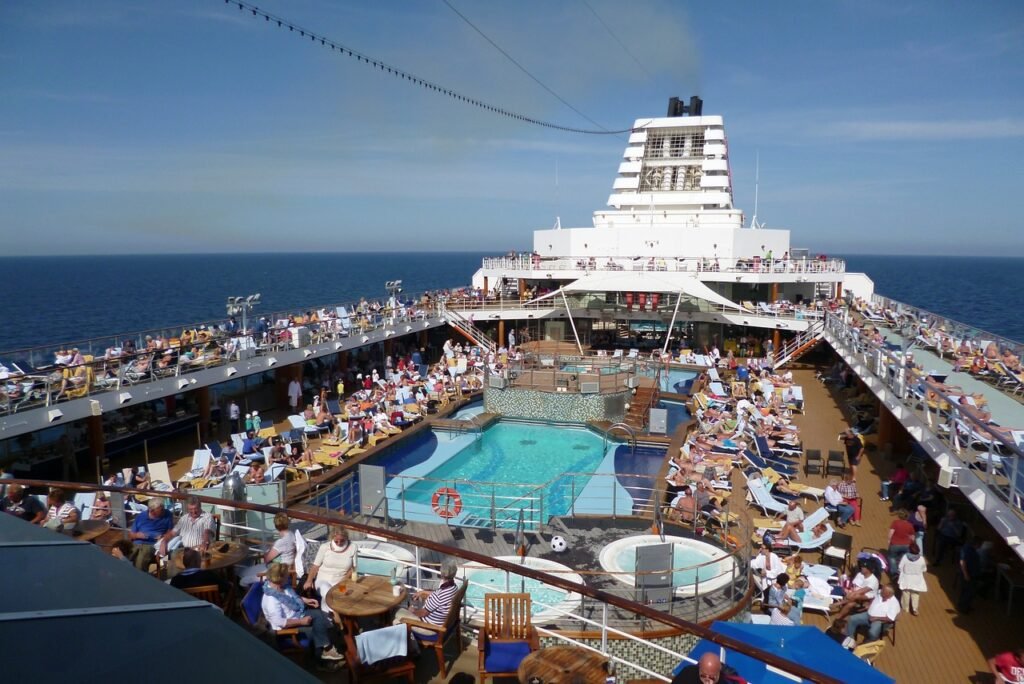Taking your first cruise is a mix of excitement and uncertainty. I still remember the lead-up to my first cruise—the thrill of knowing I’d be sailing the open seas, mixed with the nervousness of not knowing what to expect. I had so many questions: What should I pack? How do I prepare for days at sea? Will I get seasick? If you’re feeling the same way right now, don’t worry—you’re not alone.
Going on a cruise is a unique kind of travel. It’s not like flying to a destination or road tripping across the country. You’re essentially on a floating hotel, moving from one incredible location to the next. Whether you’re going on a quick getaway or an extended journey, this guide will help you prepare for your first cruise with ease.
So let’s dive in—figuratively, of course—and cover everything you need to know about preparing for your first cruise.
1. Choosing the Right Cruise for You
Before you start packing, the first step is choosing the right cruise. Cruises come in all shapes and sizes, from short weekend trips to long, multi-week adventures. The best part about cruising is that there’s something for everyone, whether you’re a laid-back traveler who wants to relax or an adventure-seeker who’s ready to explore.
What Type of Cruise is Right for You?
Length of cruise
If you’re new to cruising, you might want to start with a shorter trip. A three- to seven-day cruise is a great introduction. This way, you can get a taste of what cruising is like without committing to a long journey. If you love it, there are always longer cruises to try next time!
Destinations
Where do you want to go? Cruises sail to destinations all over the world. Some of the most popular choices include the Caribbean, Mediterranean, and Alaska. If you’re a beach lover, a Caribbean cruise might be perfect for you. If you’re more into exploring nature and wildlife, Alaska could be a dream destination.
Ship size
Cruises come in all sizes, from smaller, intimate ships to massive, floating cities with thousands of passengers. If you like the idea of lots of activities, entertainment, and dining options, a larger ship might be right up your alley. On the other hand, if you want a quieter, more personal experience, consider a smaller ship.
Pro Tip: Research Ports of Call
Each cruise has planned stops, or “ports of call,” along the way. Research the destinations before you book to make sure they’re places you’re excited to visit. Some cruises focus on tropical beaches, while others take you to historic cities or scenic landscapes. Knowing where the ship is headed can help you decide if it’s the right trip for you.
2. What to Expect on Your First Day

The first day of your cruise can feel a little overwhelming, but don’t worry—it’s all part of the adventure. The most important thing to remember is that cruise lines are well-organized, and everything will fall into place.
You’ll typically start with a check-in process, similar to an airport, where you’ll hand over your luggage, show your travel documents, and receive your key card (this card will be your room key, identification, and payment method while on the ship).
Embarkation Day Tips:
Arrive early
Many cruises recommend arriving at the port a few hours before the scheduled departure time. This gives you plenty of time to check in, explore the ship, and get settled before setting sail.
Keep essentials in your carry-on
Since your luggage may take a few hours to arrive at your cabin, pack a small carry-on bag with essentials like your ID, cruise documents, medication, a change of clothes, and any valuables you don’t want to be separated from.
Attend the muster drill
Before the ship departs, there will be a safety drill (called a “muster drill”). This is a quick demonstration of what to do in case of an emergency, and it’s mandatory for all passengers. Don’t worry, it only takes a few minutes, and then you’re free to start enjoying your cruise!
Pro Tip: Explore the Ship on Day One
Once you’re checked in, take some time to explore the ship. This is your floating home for the next few days, so get familiar with the layout, check out the pool deck, and maybe grab a bite to eat. It’s also a great time to scope out which restaurants, bars, and entertainment options you’ll want to visit later.
3. What to Pack for Your Cruise
Packing for a cruise can be tricky because you’ll need to be prepared for a variety of activities. You might be lounging by the pool one day, hiking through a rainforest the next, and dressing up for a fancy dinner later that evening. But don’t worry—we’ll break it down so you know exactly what to bring.
Clothing Essentials
Casual wear: Most of your time on the cruise will be spent in casual, comfortable clothing. Think lightweight shorts, t-shirts, sundresses, and swimsuits. Cruise ships are generally pretty laid-back during the day, so you don’t need to worry about dressing up unless you want to.
Swimwear: You’ll likely spend plenty of time by the pool or hot tub, so pack at least two swimsuits. That way, you’ll always have a dry one ready to go.
Layers: Even if you’re cruising in a warm destination, it can get chilly in the evenings or inside air-conditioned areas. Pack a light jacket, cardigan, or sweater to throw on if needed.
Activewear: If your cruise includes excursions like hiking or snorkeling, bring along some activewear and comfortable shoes. You’ll also want workout clothes if you plan to hit the ship’s gym.
Formal wear (optional): Some cruises have “formal nights” where passengers dress up for dinner. While not mandatory on most ships, it’s fun to get dressed up for a special night out. Men can wear slacks and a button-up shirt, while women might opt for a cocktail dress or nice pants and a blouse.
Other Packing Must-Haves
Sunscreen and hat: The sun can be strong on the open sea, so make sure to protect your skin with sunscreen and bring a hat to keep cool.
Toiletries: While cruise ships usually provide basic toiletries, it’s a good idea to bring your own shampoo, conditioner, and any other personal items you prefer.
Medication: Bring any prescription medications you need, along with a small first-aid kit for minor ailments like headaches or seasickness.
Power strip or outlet adapter: Cruise cabins often have limited outlets, so a small power strip can come in handy if you need to charge multiple devices.
Pro Tip: Don’t Overpack
It’s easy to get carried away with packing, especially if it’s your first cruise. Remember, you’ll likely spend a lot of time in casual wear, and you can always re-wear outfits. Stick to versatile, lightweight clothing that can be mixed and matched to avoid overloading your suitcase.
4. Seasickness: Will I Get It, and How to Prevent It?
One of the biggest concerns for first-time cruisers is the possibility of getting seasick. If you’ve never been on a cruise before, it’s natural to wonder how your body will react to the motion of the ship.
How to Prevent Seasickness
Book a mid-ship cabin: The middle of the ship, especially on a lower deck, tends to experience less motion than the front or back. If you’re prone to motion sickness, booking a mid-ship cabin can make a big difference.
Take motion sickness medication: Over-the-counter medications like Dramamine or Bonine can help prevent or alleviate seasickness. If you prefer a natural option, ginger chews or seasickness wristbands might do the trick.
Get fresh air: If you start feeling queasy, head to the top deck for some fresh air and focus on the horizon. Sometimes a little breeze and a steady view can calm your stomach.
Pro Tip: Seasickness Usually Fades
If you do experience seasickness, don’t panic—most people find that their bodies adjust to the motion of the ship after the first day or two. By the time you’ve spent a full day at sea, you’ll likely feel much better.
5. Onboard Activities: What to Do at Sea

One of the best parts of cruising is the endless list of activities available on board. Whether you’re looking for adventure, relaxation, or entertainment, cruise ships offer a wide range of options to keep you busy during your days at sea.
Popular Onboard Activities
Pools and hot tubs: Relax by the pool or take a dip in the hot tub while soaking in the ocean views.
Fitness center: Most cruise ships have a fully equipped gym where you can get a workout in while at sea.
Spa: Treat yourself to a massage, facial, or other pampering treatments at the ship’s spa.
Shows and entertainment: Cruise ships are known for their Broadway-style shows, live music, comedy acts, and more. Check the ship’s schedule for nightly performances.
Classes and workshops: From dance classes to cooking demonstrations, many ships offer workshops and activities to keep you engaged throughout your trip.
Pro Tip: Plan Ahead
When you board the ship, you’ll receive a schedule of the week’s activities. Take a few minutes to plan out your days at sea, whether you want to relax or stay active. You can always change your mind, but having a plan ensures you don’t miss out on something you’re excited about.
6. Shore Excursions: Exploring Off the Ship
One of the most exciting parts of a cruise is the opportunity to explore new destinations during shore excursions. Whether you’re interested in snorkeling, hiking, sightseeing, or simply lounging on the beach, there’s something for everyone.
How to Choose the Right Shore Excursions
Book through the cruise line: Most cruise lines offer a variety of shore excursions that you can book directly through them. These excursions are vetted, and the ship will wait for you if your excursion runs late. While booking through the cruise line can be more expensive, it offers peace of mind.
Book independently: If you’re comfortable venturing out on your own, you can often save money by booking excursions independently. Just make sure you leave plenty of time to get back to the ship before it departs!
Go at your own pace: Not every shore excursion has to be a grand adventure. Sometimes, just exploring the port city on your own or relaxing at a nearby beach can be just as rewarding.
Pro Tip: Don’t Overbook Excursions
While it’s tempting to fill every day with activities, remember that part of the joy of cruising is relaxation. Balance your days with a mix of adventure and downtime to avoid feeling rushed.
7. Disembarkation: Wrapping Up Your Cruise
When your cruise comes to an end, the disembarkation process can feel a bit hectic, but it’s straightforward. You’ll receive instructions the night before on when and how to disembark the ship, and you’ll need to pack up your luggage and leave it outside your cabin for collection. After that, it’s just a matter of saying goodbye to the ship and heading home—or on to your next adventure!
Final Thoughts
Preparing for your first cruise is an exciting experience, and with a little planning, you’ll be ready to set sail with confidence. Remember that cruising is all about relaxation and enjoyment, so don’t stress too much about the details. Whether you’re lounging by the pool, exploring a new port, or enjoying a fancy dinner on board, the key is to have fun and embrace the adventure.
Happy cruising!
Explore more. Fear less.
- Why Road Trips are One of the Best Ways to Clear Your Mind - November 21, 2024
- 10 of the Best Pumpkin Patches in the U.S. - October 23, 2024
- 10 of the Most Colorful Fall Road Trips in the U.S. - October 22, 2024
